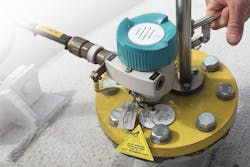Founded in 1883 in Pittsburgh, Pennsylvania, PPG Industries operates in nearly 70 countries and is a supplier of industrial coatings and specialty products. Its Stowmarket, Suffolk, plant specializes in paints used for automobile refinishing.
Even though a modern factory stands in the middle of this rural English town and a public footpath runs alongside the Rivers Gipping and Rat, which meet in the middle of the property, the factory’s solvent storage tanks do not look out of place so close to a green space.
PPG values protecting the ecosystem from the potentially explosive solvents with which it works. Its recent efforts to further improve the safety and efficiency of its storage systems led it to Siemens Process Instruments through system integrator Lark Technology and distributor Process Instrument Sales.
The challenge
Over the years, the paint manufacturer used several techniques to gauge the level of material within its varied storage vessels at the Stowmarket plant. Most recently, for example, the level in each of the 33 tanks containing various solvents was measured using a bubbler system. Unfortunately, not only was this system error-prone, it was also labor-intensive to use, maintain and test.
Still, it was a system that worked adequately for the company through the years. This all changed, however, when the U.K.’s Health and Safety Executive (HSE) enacted strict legislation in response to the Buncefield disaster, during which an oil storage facility in Hertfordshire, England, was destroyed in a series of explosions in December 2005. The accident was caused by an overflow during the remote-filling of a storage tank when multiple systems failed, including the main level gauge and the final point level device.
Now the HSE legislates that such storage vessels containing potentially flammable materials should have continuous level measurement devices, a high-level switch and an operator visually monitoring the tank contents as it is filled.
A new control system was put in place to meet these safety standards.
The solution
Lark Technology, accompanied by Process Instrument Sales, designed a new system for PPG Industries from the bottom up. A radar transmitter and a point level device were installed on each of the paint manufacturer’s 33 storage tanks, and then tied into a custom-built control system using Profibus and intrinsically safe Profibus. In this configuration, each radar transmitter provides continuous level readings, while the point level switch provides high-level system protection from overfill.
“What started out with the criteria of an overfill protection scheme is now supporting the site’s procurement department to manage stock levels and to maximize efficiency with available solvent storage space,” said James Rawlings of Lark Technology.
The first piece of the new technology is a noncontacting radar transmitter designed for easy installation and quick configuration. With its small antenna, the device can be installed practically anywhere on a vessel, and its high frequency makes for an impressive signal-to-noise ratio, a feature further improved by echo-processing software.
Next is a vibrating level switch for use liquid and slurry applications such as overflow, high, low and safety integrity level (SIL)-2 applications. The device is cost-effective, easy to install, and acts as a security device in the unlikely event that the primary level detector fails.
The radar transmitters are connected to the plant’s control system through Profibus, an industrial communication protocol that provides fully integrated, two-way networking between a control system and each of its field devices.
During installation of the new system, extensive validation was carried out to satisfy the HSE.
The radar transmitter can also provide:
- Volume calculations — Specific to each tank, this value is derived from the capacity of a tank and the current level of liquid within it.
- Trending — In this system, all tanks are monitored when one is being filled so operators know immediately if a routing error or leak exists.
One life cycle requirement of the system, as defined by the HSE, was that all point level devices be tested regularly, a proposition that was time-consuming as well as problematic. The 500-millimeter probes are located inside the vessel, and the chances of damaging them increase each time they are removed. A way of testing them in-situ was needed, so a custom solution was engineered.
The new testing device is a long, hollow rod with a small pot at its end that is supported directly beneath the tip of the probe. For testing, the cup is filled remotely through the hollow rod using an industrial syringe with the same solvent that is in the vessel. The rod and pot arrangement is lifted so that it covers the sensing end of the probe. In this way, the system can confirm that the probe operates with the actual product in the tank. Afterward, the pot is lowered back down, the same syringe is used to remove the test liquid, and the handle is locked in place until the next test.
The benefits
With the new equipment in place and connected to the control system, PPG is reaping the benefits of an integrated, automated system with data control. The new level monitoring equipment allows the company confidence that, because they know what is going on in all of the tanks even when they are just working with one, they are meeting the necessary HSE standards. The new custom solution for testing point level probes in-situ does so in a manner that does not risk damaging them.
PPG plans to install more devices on the next phase of the project on-site at Stowmarket.
Herman Coello is product marketing manager for Siemens.


